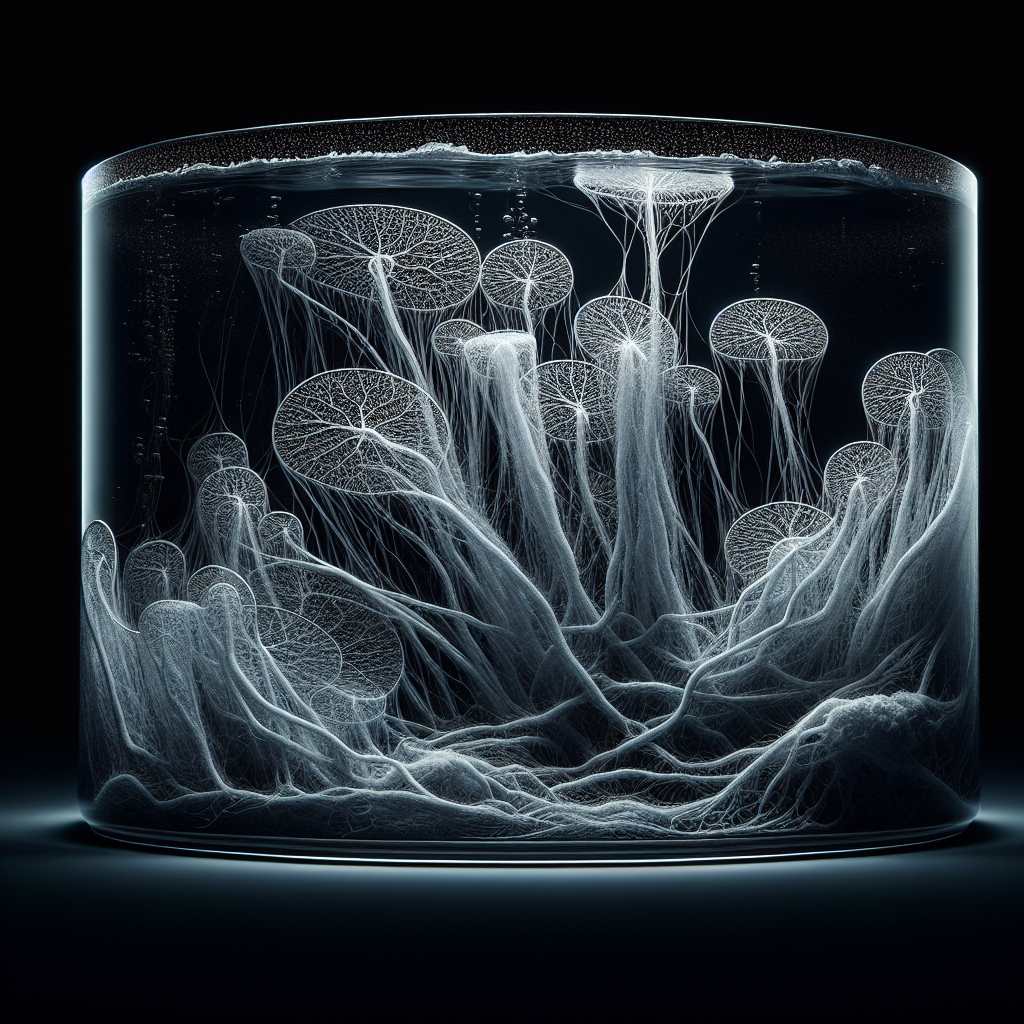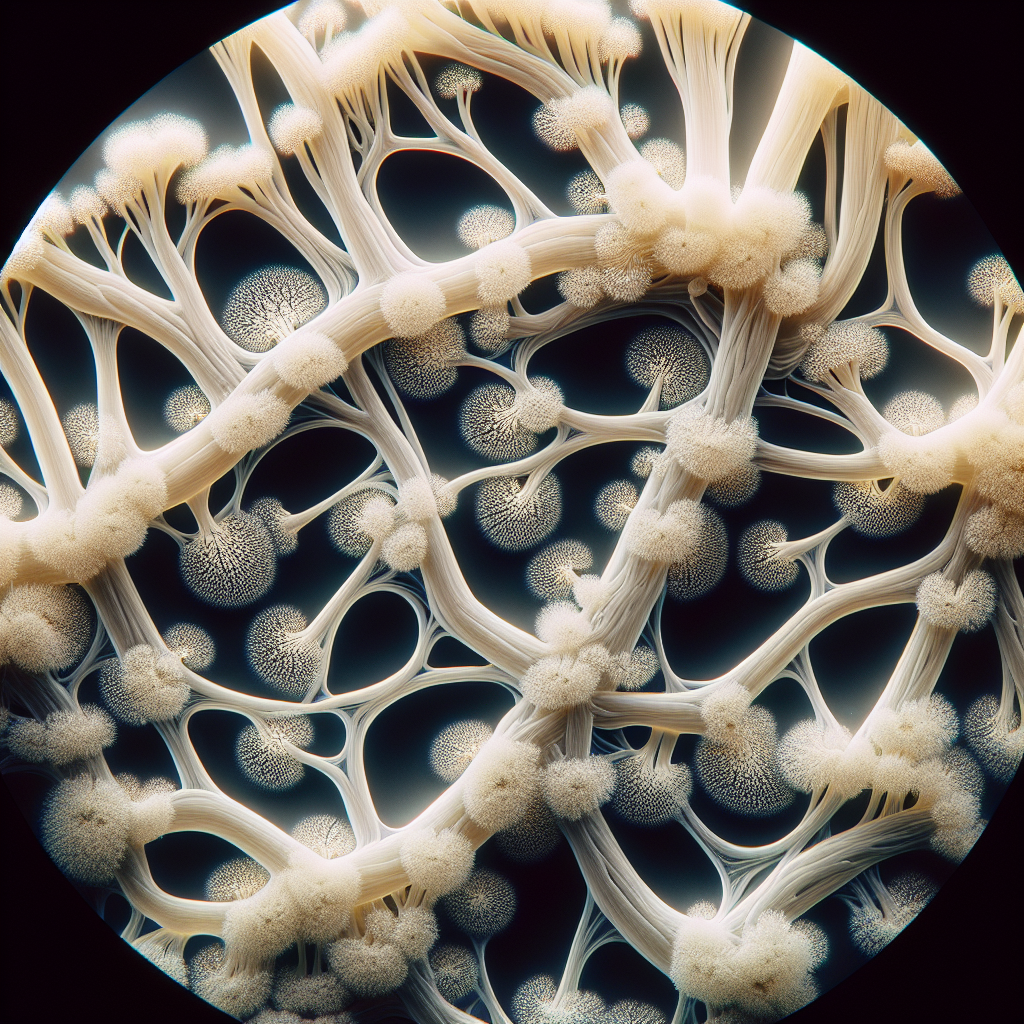In the scientific realm, the question of whether mycelium can grow in water has often stirred considerable interest. “Exploring the Survival and Growth of Mycelium in Water” probes into this subject matter, deciphering the complex biology of mycelium – an integral part of fungal organisms – and shedding light on its ability to survive and proliferate in an aqueous environment. Drawing from numerous research and studies, this article aims to provide illumination on this intriguing aspect of mycology, potentially revolutionizing our understanding of fungi and offering potential implications for industries such as those involved in biomass-produced renewable materials and mushroom cultivation.

Understanding Mycelium
Mycelium is the vegetative part of a fungus, predominantly composed of a mass of branching, thread-like hyphae. It is essential to the growth and reproduction of fungi and plays a significant role in nutrient and water absorption.
Identifying Characteristics of Mycelium
Mycelium often appears as white or cream-colored strands spreading across the substrate it is growing on. It can be found on a wide variety of surfaces, from wood and soil to decomposing organic material. When examined under a microscope, the mycelium’s intricate network of hyphae can be clearly seen, characterized by their tubular structure and multicellular composition.
Role of Mycelium in Ecosystem
Mycelium fulfills a vital task in ecosystems by decomposing plant material. It breaks down complex organic compounds into simpler ones that plants and other organisms can use, essentially recycling nutrients within the ecosystem. Mycelium also forms symbiotic relationships with plants, known as mycorrhizal associations, where it helps the plant absorb water and nutrients while the plant provides it with sugars produced through photosynthesis.
How Mycelium Networks Function
Forming an underground network, mycelium serves as a communication hub and nutrient exchange between plants in a forest ecosystem. This extensive networking function enables it to transfer nutrients and water to where they are most required, sustaining the health of the entire plant community.
Mycelium Growth Conditions
Understanding the ideal growth conditions for mycelium is critical for anyone keen on cultivating it. Various parameters can influence the growth, including temperature, humidity, and nutrient availability.
Ideal Conditions for Mycelium Growth
Mycelium prefers dark and moist conditions with a humidity level of about 90-100%. It typically grows best under a temperature range of 70-75 degrees Fahrenheit (21-24 degrees Celsius). A neutral or slightly acidic pH environment is also desirable.
Effects of Temperature and Humidity on Mycelium
The correct temperature and humidity are crucial for optimal mycelium growth. If the temperature is too high or too low, it can prevent growth and even kill the mycelium. Similarly, if the humidity is not maintained well, the mycelium will either dry out or become too waterlogged.
Mycelium’s Nutrient Requirements
Mycelium requires a consistent supply of nutrients to thrive. It usually absorbs nutrients from the substrate it colonizes, such as sugars, starches, and lignin from wood or other organic material. Different species of mycelium may have different nutrient preferences depending on their natural habitat.
Mycelium and Water: A Complex Relationship
Water is indispensable to the growth and survival of mycelium, playing a significant part in nutrient absorption and providing an environment for hyphal growth.
Role of Water in Mycelium Growth
Water aids in mycelium growth by maintaining the humidity levels that the organism thrives in. Through the process of osmosis, mycelium absorbs water from the environment into its hyphae, enabling essential metabolic processes required for growth.
How Mycelium Absorbs Water
The mycelium absorbs water through its intricate network of hyphae. Each hypha expands as it absorbs water, aiding in the growth of the mycelium network. The cell walls of the hyphae are semi-permeable, allowing water to pass into the cell while preventing substantial molecules or ions from passing through.
Water Requirements of Mycelium
While the mycelium requires water for growth, excessive water, or waterlogging conditions can be detrimental, leading to oxygen deprivation and subsequent death of the mycelium. Thus, it’s critical to balance the moisture levels to curate an optimum environment for mycelium growth.

Experimenting with Mycelium Growth in Water
The capacity for mycelium to grow in water bodies has been a recent area of exploration, revealing fascinating insights and implications for aquaponic systems.
Methods for Growing Mycelium in Water
Cultivating mycelium in water systems entails developing a nutrient-rich ‘water-based’ substrate for the mycelium to colonize. Grains or wood chips can be employed to this end, suspended in water to provide the necessary nutrients.
Observations and Findings
While ongoing, current research indicates that mycelium is indeed capable of growing underwater, albeit at a slower rate compared to terrestrial environments when cultivated under ideal temperature and nutrient conditions. Furthermore, it appears that the mycelium forms denser networks underwater, potentially as a survival adaptation.
Implications for Aquaponic Systems
These findings present exciting potential for incorporating mycelium into aquaponic systems, serving as both a biological filter aiding in nutrient cycling and an edible crop. Given the right condition, mycelium could potentially open new paths for sustainable farming methods.
Challenges of Growing Mycelium in Water
While promising, the cultivation of mycelium underwater bears a set of unique challenges and limitations that need to be addressed to harness its full potential.
Potential Issues and Limitations
One of the significant hurdles in growing mycelium in water is the risk of anaerobic conditions. mycelium requires oxygen to survive, and too much water can lead to oxygen deprivation. Additionally, the risk of contamination is higher in water, especially without a proper filtration system.
Reaction of Mycelium to Overwatering
Overwatering can be detrimental to mycelium, leading to oxygen deprivation and potentially causing the mycelium to drown. Mycelium in overwatered conditions also become more susceptible to diseases and pests, which can further hamper growth.
How Underwatering Affects Mycelium
On the flip side, underwatering can dry out the mycelium, disrupting its hydration balance and impeding its growth. Without adequate water, mycelium cannot expand its hyphal network and effectively colonize the substrate.
Adaptations of Mycelium to Aquatic Environments
Mycelium and certain fungi can show a remarkable ability to adapt to aquatic environments, exhibiting unique survival strategies.
Special Adaptations of Aquatic Fungi
Some fungi, also known as water molds, have evolved to thrive in water. They are often found in freshwater habitats and have specialized structures to help them survive and reproduce in these environments.
How Mycelium Survives in Water-soaked Conditions
Mycelium in water-soaked conditions often responds by forming a denser network of hyphae, possibly to increase their surface area for nutrient and oxygen absorption. Some may also produce a waterproof coating around their hyphae to shield them from water damage.
Mycelium’s Response to Flooding and Drought
When faced with flooding, mycelium can upregulate genes associated with metabolic processes to cope with oxygen deprivation. Conversely, during drought conditions, it can alter its metabolism to minimize water loss and protect its cells from dehydration.
The Effects of Water Quality on Mycelium Growth
Water quality can significantly impact mycelium growth, affecting its ability to absorb water and nutrients effectively.
Impact of Water Contaminants on Mycelium
Mycelium can be highly sensitive to water contaminants, such as heavy metals or chemical pollutants. They can disrupt cellular processes in the mycelium, leading to impaired growth or even death. Some mycelium species, however, are being studied for their capacity to absorb and sequester certain pollutants, providing potential applications for bioremediation.
Role of pH in Mycelium’s Water Tolerance
The acidity or alkalinity of the water, as measured by pH, can influence mycelium growth. Most prefer slightly acidic to neutral pH levels, and any significant deviation can impede its metabolism and growth.
Effects of Hard and Soft Water on Mycelium
Hard water, which contains high concentrations of calcium and magnesium ions, can hinder mycelium growth. Conversely, soft water, low in these ions, might not provide the necessary nutrients for optimum growth, emphasizing the need for a delicate balance.
Mycelium in Aquaculture and Hydroponic Systems
Integrated aquaponics and hydroponics systems exhibit immense potential for incorporating mycelium, leading to more sustainable and efficient farming methods.
Benefits of Incorporating Mycelium into Aquaponics
Incorporating mycelium into aquaponics systems can deliver multiple benefits. It can serve as a biological filter, aiding in the breakdown of waste material. Mycelium’s capacity to absorb nutrients can be harnessed to eliminate excess nutrients in the water that might otherwise contribute to unfavorable algal blooms.
Possible Issues and Solutions for Hydroponic Growth
Hydroponic cultivation of mycelium may face issues, such as maintaining the correct balance of nutrients and managing potential contamination. These challenges could be addressed by carefully monitoring nutrient levels, maintaining ideal temperature and humidity conditions, and employing effective filtration systems.
Innovations in Mycelium-based Water Purification systems
The potential of mycelium for water purification merits further exploration. Emerging research suggests that certain fungal species can absorb and immobilize heavy metals and other pollutants in water, presenting promise for eco-friendly bioremediation techniques.
The Impact of Mycelium Aquatic Growth on Ecosystems
The potential impact of mycelium growth in aquatic ecosystems can be profound, influencing local food chains, ecosystem health, and offering potential for water purification.
Mycelium’s Role in Aquatic Food Chains
In an aquatic ecosystem, mycelium can be a primary decomposer, breaking down organic material into simpler forms that other organisms can readily use. This makes mycelium an integral part of the aquatic food chain, helping to recycle nutrients in the ecosystem.
Effects on Water Quality and Ecosystem Health
By aiding in nutrient cycling and potential water purification, mycelium can significantly contribute to improving water quality. This can enhance the health of the larger ecosystem, promoting biodiversity and stability.
Potential for Mycelium-based Bio-Remediation of Polluted Waters
Mycelium shows a promising potential for bioremediation of polluted waters. Certain species can absorb and sequester pollutants, including heavy metals and organic pollutants, thus helping clean up contaminated water bodies.
Future Research Possibilities in Mycelium Aquatic Growth
The field of aquatic mycelium growth is ripe with opportunities for further study and potential innovations in various areas, including water conservation and ecosystem management.
Emerging Science on Mycelium and Water Interactions
Our understanding of the complex interactions between mycelium and water continues to grow. Future research could explore the intricate biochemical and physical processes that enable mycelium to adapt and survive in various aquatic conditions.
Potential Innovations in Mycelium Utilization
The unique properties of mycelium, such as its ability to form vast networks, absorb nutrients efficiently, and potentially purify water, offer various opportunities for innovation. From sustainable farming methods to eco-friendly water treatment solutions, the prospects are immense.
Implications for Ecosystem Management and Water Conservation
By managing mycelium growth in aquatic settings, we can potentially improve the health of our ecosystems while conserving water resources. Future research in this area might focus on harnessing the properties of mycelium for efficient nutrient cycling, water purification, and sustainable aquaponics. In conclusion, the study of mycelium and its interaction with water offers a promising frontier in ecological research and sustainable solutions.
